Before proceeding with the restoration - assess the situation
What you need: a tape measure, a small ruler, a level, a plumb line, a needle probe.
Before starting work on the restoration of brickwork, it is necessary to assess its technical condition. The research can be conditionally divided into three stages.
Surface inspection
Visual assessment reveals:
- cracks on the surface of the brickwork,
- destruction (looseness, chipping, chips, potholes) and / or the absence of individual bricks,
- weathering of seams,
- stratification of rows of masonry,
- rust stains and efflorescence on the surface,
- fungus, mold, moss.
Rust on the surface of the masonry is a sign of loss of solidity of the structure due to corrosion of steel embedded parts or reinforcement.

Measurements
To clarify the data obtained during visual inspection and to assess the degree of damage, it is necessary to measure:
- thickness and depth of cracks,
- the thickness of the seams,
- angles of deviation of the masonry from the vertical and horizontal in the plane of the wall (at the seams),
- angles of deviation of the masonry from the plane of the wall.
Before restoring brickwork, it is necessary to eliminate the root causes of deformations, otherwise repeated destruction cannot be avoided.

> Control of the development of deformations
If cracks appear in the masonry, it is necessary to trace the dynamics of destruction. For this you need:
measure the initial width and depth of the crack, mark the place of measurement by installing beacons (made of paper or plaster);
track dynamics at regular intervals;
eliminate the root cause of deformation, which most often consists in subsidence of the soil, foundation or part of a building;
make sure that the state of the cracks has stabilized.
Composition analysis
If there are efflorescences on the masonry, it is also recommended to conduct a laboratory study of their chemical composition. It allows you to find out the amount of sulfates, nitrates, salts and moisture contained in the masonry.
Material for analysis is taken from four points distant from each other.

Cases when masonry is considered emergency
Bricks or masonry blocks overhang and threaten to fall.
The masonry is inclined from the vertical by more than 1/200 of the height of the wall or 1/3 of the thickness of the masonry.
The masonry bulges (protrudes from the plane of the wall) by more than 1/200 of the height of the deformed area or 1/3 of the thickness of the masonry.
Cracks cross four or more rows of masonry.
Damage to the masonry is more than 2 cm deep.
Disorder or stratification of the masonry rows is observed.
Calculation of the amount of primer
The quantitative calculation of the primer composition is a material indicator as part of the cost of finishing work. There are no uniform reference standards, since when determining the consumption, it is necessary to take into account the surface condition, the number of layers of application of the composition, the type of finishing material.
Average indicators per 1 square meter in one layer, indicated by the manufacturer, and they are approximately as follows:
- acrylic primer - 130 -150 g / m2;
- water-dispersed soil - 100 g / m2;
- deep penetration soils - 180 g / m2.
It will be correct when calculating to increase the total amount of the composition by 10%. This is due to the fact that there may be corners and protrusions on the surface, which have to be primed with a slight waste of material.
So, when calculating the amount of soil, it is necessary: measure the surface area, multiply this indicator by the average consumption, then multiply by the number of layers and add 10% of the obtained value. This will determine the total amount of primer.
Varieties of coatings
For repair and restoration work with your own hands, it can be used paint on brick water or organic based. Water- and organic-soluble formulations have their own disadvantages and advantages:
Organosoluble nitroenamels and oil dyes
They penetrate well into the brick structure, are resistant to UV rays, but create a thin, durable water-repellent film on the surface, which prevents the material from "breathing" and provokes the formation of condensation.
It is not recommended to use organic-soluble mixtures in the interior of a residential building: the walls will become damp, the internal microclimate of the premises will be disturbed. They are well suited for painting the facade, brick balconies and fences, provide full protection from atmospheric agents, do not fade, but are toxic.
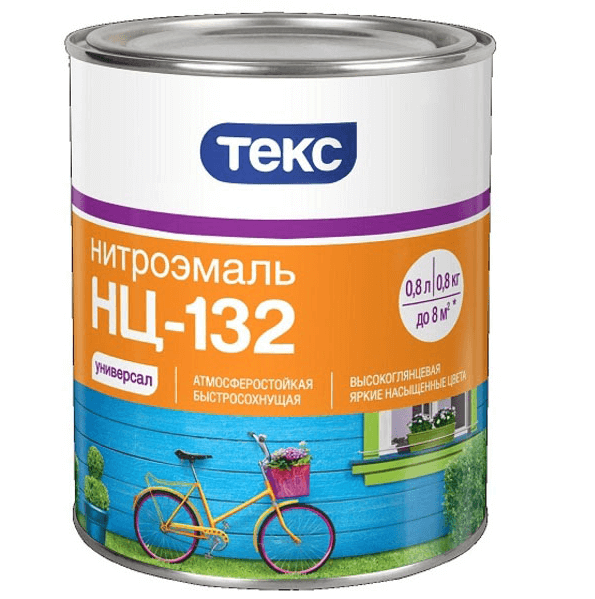
Water soluble
These paints are very durable, they are used for painting walls outside. They can even paint a brick oven heating pipe or gas-heating draft, as well as carry out finishing work inside the house. Suitable for simple, sand-lime and gypsum bricks or gypsum tiles (imitation brick).

Water-borne facade paint
They have good vapor permeability, providing full water and gas exchange between the atmosphere and the surface. Non-toxic, fireproof, they can be used to decorate the interior of the premises. They can be produced with heat-resistant qualities.
If the tiling is ceramic, you need to look in the direction of special tile paints.
Epoxy
They have various qualities. Depending on their constituent resins, they can be toxic and non-toxic. They are distinguished by increased adhesive properties and strength, but are poorly resistant to weathering. Painting a plaster brick wall or indoor decoration tile can guarantee the quality and durability of the coating. They can be used to paint a covered balcony from the inside.
These colorants can be varnished to increase their weatherability. For living rooms, it is advisable to select non-toxic solutions, carefully reading the composition and scope of the package.
Mineral
Cement-based brick paint is well suited for facade work, for decorative painting of a facade, balcony or fence. Possesses high water and heat resistance, is able to withstand the onslaught of heavy rains and temperature drops, reliably protecting the fence or building facade from destruction. It is rarely used for interior decoration.
Silicone

When choosing how to paint a brick or decorative tile with low adhesive properties (usually silicate products), it is better to stop at silicone mixtures that fit well on a smooth surface and do not fade for a long time. They can be produced with heat-resistant properties - for decorating stoves and fireplaces in the interior.
Waterproofing bricks: is it really needed?
Despite all the advantages, the brick has one significant drawback - susceptibility to moisture. The brick is characterized by a porous structure that allows it to quickly absorb water. This leads to three undesirable points:
1. High humidity indoors. It is fraught with the development of a fungus. Residents of such houses are more often diagnosed with colds, chronic diseases develop.
2. Reducing the thermal insulation properties of the walls. Wet walls are less effective at keeping heat indoors.
3. Destruction of masonry. Together with water, various salts penetrate into the brick from the soil, which gradually destroy it. In winter, moisture inside the brick freezes and expands, which also leads to the destruction of the masonry. Also, due to the increased humidity of the walls, the reinforcement, which serves to increase the strength of the structure, rusts and collapses.
When brick waterproofing is neglected, the durability of the building is significantly reduced. For residential buildings, this is dangerous not only by the premature destruction of the walls, but also by the development of mold.
Although the brick quickly absorbs water, it is advisable to protect only the lower part of the wall from moisture: in the place where the brickwork is in contact with the foundation. The concrete foundation is constantly in contact with groundwater. In the absence of a waterproofing layer, the movement of water is not limited to the foundation, but extends to the brick wall. In this case, the wall gets wet throughout its entire thickness and can damp right up to the roof itself.
Waterproofing of bricks is performed not only along the wall itself: it is important to completely cut off the brickwork from the foundation so that water cannot move upward along the entire thickness of the wall. The second layer of shut-off waterproofing is laid on top of the basement, since the basement is also a weak point of the building: in winter it is covered with snow, and in spring it is filled with melt water
It is impractical to isolate the wall along the entire height, because rainwater soaks only the outer layer of the masonry, and it dries quickly under the influence of wind and sun. Although, to increase the durability of the building, it would be useful to cover the walls with paint, liquid rubber or decorative plaster.
How to protect a brick from destruction: methods of protection - Working with Brick
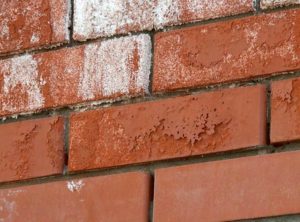
Brick buildings are reliable and aesthetically pleasing
The mass construction of brick buildings and structures does not decrease with the advent of new building materials. Such structures are distinguished by their strength, stability and long service life.
However, brickwork is susceptible to the adverse effects of many factors, and the result can be a violation of its integrity. What reasons can contribute to this, how to protect a brick from destruction, we will consider in more detail in this article.
Protecting bricks from destruction
(Some measures to prevent the destruction of masonry and to protect the brick)
When looking at the centuries-old walls of the Moscow Kremlin, it is difficult to imagine that brick is a very delicate material.
Even a brick made in compliance with all production technologies, without proper handling, can significantly lose its structural properties, or even simply disintegrate into mechanical components.
And half the trouble if this happens to the material that has overwintered on the construction site - it is much worse if the already erected building suffers.
Ceramic brick, as you know, consists of clay with the addition of sand, silicate - of sand and a binder component, lime. After molding, the components of the ceramic brick are soldered in a high-temperature oven.
Silicate brick is not subjected to firing, the technology of its production involves steaming a sand-lime mixture.
There is a difference in the ability to absorb moisture between brick and brick: this difference is due to such a characteristic as water absorption, which, in turn, is linked to frost resistance - the ability to maintain mechanical strength after a certain number of freezing and thawing cycles.
For example, if we compare ceramic and silicate bricks, then the ability to absorb moisture in silicate bricks is much higher. The brick absorbs moisture, and that, condensing and freezing, destroys it from the inside.
And here it is necessary to warn against a gross mistake those who believe that it is useful to spend the winter without finishing with a brick box of a house under construction. It is very likely that as a result of atmospheric influences, for which the brick, in principle, is not designed, it will begin to crumble.
Indeed, under normal building conditions, the brick heats up from the inside of the house, and from the outside it is protected either by plaster or some other facing material (at least the same facing brick, which has a lower water absorption rate and higher frost resistance).
Protecting a brick building from atmospheric precipitation is a measure that helps to prevent such a destructive phenomenon as efflorescence.Whitish erosion on brick facades is formed as a result of wetting the brick, followed by its drying.
Salts protruding to the surface are contained both in the Cambrian clays rich in them and in building solutions, and in the latter case, the use of special additives in winter to restrain the freezing of the solution increases the likelihood of efflorescence.
Efflorescences not only spoil the appearance of the building - the plaster from the surfaces affected by them comes off as easily as the paint layer. There is an opinion that some salts, accumulating inside the brick in the form of constantly growing crystals, are also capable of destroying the brickwork itself.
Types of brick primers
Brick is a building material that is made from natural mineral raw materials with the addition of dyes, which means that the material for its processing must be combined with mineral surfaces.
Deep penetration formulations
As a rule, these are water-dispersion compositions, which during processing strengthen the surface and create conditions for good adhesion of materials. They should be used during repair work, when the plaster layer is removed from the walls, and the base has a loose structure.
Acrylic compounds also belong to deep penetration soils. They dissolve easily in water, are odorless and environmentally friendly.
It is good to use alkyd primers before painting surfaces, but the interaction with plaster solutions is negative.
Mineral soils, which are based on gypsum, cement and lime, interact well with any brick, penetrate deeply into the structure, and strengthen the surface. Can be used both indoors and outdoors.
Facing brick primer
Priming of facing bricks is necessary in case of discoloration (staining) or to protect against moisture and efflorescence (appearance of white plaque on the surface).
Brick processing is carried out with water repellents - compounds that reduce the water absorption of the surface. This allows you to close the pores and "bind" free radicals of salts, which are in the raw materials for the production of bricks, and come to the surface with moisture. In addition, water-repellent primers create a glossy film on the surface, which emphasizes the color of the facing brick. It is necessary to treat surfaces with such a composition as efflorescence appears, and preferably every 2 years.
Sand-lime brick primer
The priming of silicate bricks must be carried out in order to reduce its water-absorbing properties. It is necessary to solve this problem with the use of universal primers for mineral surfaces, in particular acrylic. Such soils will help protect the surface of the walls from the appearance of fungus and mold.
For painting walls made of silicate bricks, silicate paint is used, under which the walls are primed with a silicate primer based on potash water glass. Such compositions can be used to treat building facades.
Gypsum brick primer
The compositions with which gypsum walls are processed are designed to reduce water absorption. These are deep penetration water-repellent mixtures. Such primers protect against mold and mildew, create adhesion conditions for various materials. As a rule, these are acrylic-based primers.
Walls treated with such a composition can be painted, tiled, plastered.
Brick hardening primer
Such a primer is necessary for weak and crumbling surfaces. Deep penetration primers bind weak particles of the surface of the brickwork. For strengthening, you can also use cement-based mineral compounds. They will also help to level the surface.
Another purpose of strengthening primers is to fix cement joints and prevent them from falling out of the masonry.
The best option is a deep penetrating acrylic primer.
Acrylic mix for outdoor use
When processing the facade of a building or brick fences with primers, it must be borne in mind that the brickwork after processing must acquire the following properties:
- be waterproof;
- have low water absorption;
- resist the appearance of fungus and mold;
- get adhesive qualities;
- become fortified.
The acrylic mixture will help to cope with all the described tasks due to deep penetration into the material, blocking all pores and cracks.
By reducing water absorption, the primer, thus, increases the frost resistance of the brick, since it does not allow moisture to penetrate deep into the surface.
Fungicidal additives in the composition will cope with spores of fungus and mold.
The surface vapor-permeable film that appears on the surface after processing creates conditions for adhesion to almost any finishing material.
Coating waterproofing
Bitumen-based materials are applied to a pre-cleaned wall: traces of dirt and mortar flows protruding from the seams are removed from the surface. After that, the walls are primed. For high-quality adhesion of the waterproofing layer to the brick, the surfaces are treated with a liquid primer.
Only then proceed directly to the waterproofing of the brick. Professional builders apply the mortar using a special spray installation. It's faster and more convenient. If there is no such equipment, coating waterproofing or cold mastic is applied to the walls with a roller, brush or spatula. The work is going much slower, but the quality does not suffer from this. If the solution is too liquid, it is applied in two layers.
When waterproofing bricks with liquid rubber, the sequence of actions is the same, however, drying of the walls is added. Liquid rubber does not adhere well to damp surfaces, so the walls are thoroughly dried and then primed with a special compound with deep penetration into the brick. Such a coating tolerates house shrinkage well and does not lose its integrity even if the wall cracks.
Concrete-based hydrophobic mixtures and asphalt plaster are used both indoors and on the exterior walls of the house, but it is recommended to apply them only after the house has shrunk. Otherwise, cracks will appear in the waterproofing layer.
Tips & Tricks
After the material is selected, a completely logical question arises - how to use the tool correctly. To do this, use the advice and recommendations of specialists, which will definitely come in handy for each of you:
- As a rule, the water repellent agent is a concentrate, therefore it is recommended to dilute it with plain water before use.
- Before applying the liquid to the brick surface, make sure it is thoroughly cleaned and free of mold or mildew. If necessary, it is recommended to treat the surface with special antiseptics, and only then start work.
- Brick, unlike concrete, has a less porous surface, so it will be enough to apply one layer of a special tool. If the surface needs double processing, then this should be done after fifteen to twenty minutes.
- After applying the layer, the surface should be slightly shiny. If this has not happened, then most likely you have applied insufficient amount of fluid.
- It is necessary to work with a water repellent only at positive temperatures. The weather should be dry, as the surface should be protected from bad weather during the day.
In the next video, you will see a demonstration of the capabilities of the water repellent for Litos bricks.
Wall masonry protection
Effect of hydrophobization on a brick wall.
The joints of the brickwork above the basement are also vulnerable to moisture.Ceramic stone is used most often today, due to excess moisture, it begins to deteriorate.
Brick is a porous material, and the seams of the masonry can be called a weak point. When moisture rises along the walls, the following troubles are possible:
- the appearance of whitish salt formations;
- in winter, moisture freezes to form ice;
- destruction of masonry;
- heat leaves the building.
The processing of the brick surface is carried out in stages.
After processing, it will be completely protected. In addition, brick walls will become very beautiful, and the durability of the structure will significantly increase. The product creates a water-repellent layer and excellent vapor barrier. This is achieved due to the penetration of the impregnation into the brick by 1 cm. As a result, the wall made of stone is not afraid of rain, the ingress of snow and melt water will also not have a harmful effect.
Impregnations are available in specialized stores. It is worth mentioning the following products, which differ from each other in composition:
Impregnation varnish for bricks.
- Water-repellent impregnation for bricks. It is in demand most of all, since the product has excellent protective characteristics.
- Silicone impregnation. A water-based product, it consists of 2 components.
- Varnish-impregnation. When applied to walls, you get a surface with a slight gloss.
- Silicone-acrylic impregnation.
Impregnation for bricks has a water-repellent effect. On the surface of the brickwork, the products form a very thin hydrophobic film, which reliably seals the pores of the brick, preventing moisture from penetrating inside. The destruction of the brick stops.
Before starting work, you need to determine the sources of moisture penetration. To do this, examine the seams. If they are not destroyed, then simply apply the impregnation to the walls. In case of visible destruction of the seams, first carry out restoration work, and only then cover the walls with a protective agent.
Inspect stone walls once a year. Remove dirt with water or a special paste. Mechanical cleaning is no less effective. Use special solutions to remove traces of salt on the walls. Be sure to treat mold and mildew with antiseptics.
Best applied to dry, clean brick walls. Wait for dry weather and then get to work. If the mortar crumbles in the seams of the masonry, remove it. Replace crumbling parts of the masonry, lay a new brick. Apply the impregnation to the masonry, let dry. This is a preliminary stage of work. Then close all the seams.
If you want to get a good result, then make sure that at least a day elapses between the preliminary impregnation of the masonry and the finishing part of the work. After that, seal the joints by applying a cement-sand composition with a layer of 2 mm. Rub the solution diagonally with the sponge. Remove excess and wait until the mortar has set completely. Rinse the wall thoroughly with cold water to remove any residue. Cover seams from sunlight. Wait 3 days and then apply the finishing coat. It is an excellent hydrophobic coating for sand-lime bricks.
If you do not need to repair the seams, apply a protective impregnation in 2 layers. A little time should pass between the 1st and 2nd layers, but it is enough to wait 15 minutes. There should be a visible shine on the wall, such a coating will last for at least 10 years. Now you know all about how to protect walls.
Coating features
The principle of working with varnishes is similar to painting. First of all, you need to prepare the surface to be treated. Walls should be cleaned of dirt and dust, cracks should be putty, build-ups should be cut down, and recesses should be filled with plaster or putty. If the facade has been painted before, the paint should be removed completely.
Aligned walls need to be sanded with coarse sandpaper and then washed. A household detergent is suitable for this. After drying, a second inspection is carried out. The identified shortcomings are eliminated. A dry, clean surface is primed.It is advisable to take a primer and varnish from one manufacturer.
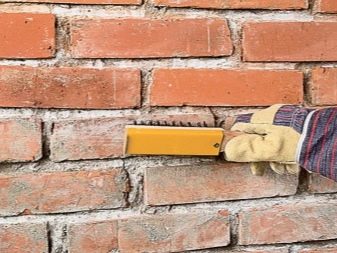
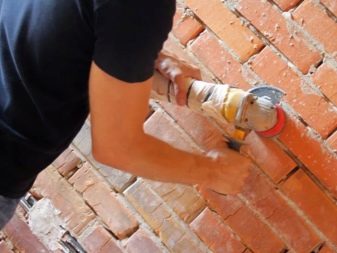
Application is done in several ways: by brush, roller or spray. In the latter case, the mixture (if it is not in an aerosol can) must be mixed with a solvent to reduce the density. If this is not done, the spray gun will not cope with heavy varnish.
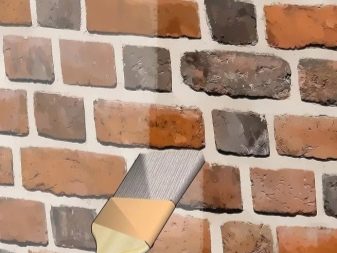

The varnishing starts from one of the upper corners, gradually going down. On large areas, it is convenient to work with a 20 mm nap roller. Small elements are processed with a brush with natural stiff bristles. Neighboring strokes should be applied with an overlap of a few millimeters. The varnish is applied in two or more layers. Each subsequent layer is applied after complete drying (absorption) of the previous one.
Maintenance of the varnish coating consists in processing with a mild detergent at a frequency of 2 times a year.
See below for more details.
Salt protection

salt protection
At the heart of a brick product are components containing only natural raw materials - clay. After a certain period of time, peculiar spots may appear on the surface of the brick - efflorescence. A small amount of salts are present in the solution. Of course, white stains greatly spoil the appearance of the wall. But this fact is not yet the worst. The presence of salt deposits on the surface indicates that the process of destruction of both the wall and the mortar is slowly but surely going on.
To eliminate such a defect as efflorescence, special preparations are used. However, before proceeding with the application of the product, it is necessary to carry out preparatory measures. The condition of the roof is carefully checked, if necessary, a new waterproofer is installed, the gutters are being improved. These preventive measures will help reduce moisture ingress on the wall.
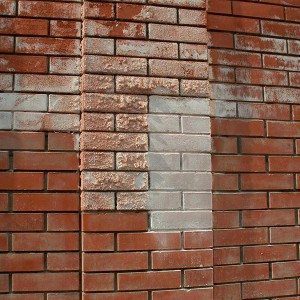
examples of efflorescence
Efflorescences are quite often one of the first signs of the beginning of the destruction of brickwork. With the first appearance of a specific white bloom, you should be extremely careful and watch out, since cracks, mold, and greenery may appear in the near future.
Do not be lost in guessing how to process the brick from destruction. Today, the most effective means of protecting masonry from moisture and other liquids are water repellents. It is a special composition of silicon-based components. It is used in many stages of construction to achieve a water-repellent effect. It is used to process artificial stone, bricks, and ceramic tiles, even concrete, slate, cinder block, gypsum, etc.
Protection of brickwork with a water repellent increases frost resistance not only of individual elements, but also of the entire structure. In addition, it helps to improve the indicator of such properties as strength. Quite often, this tool is used in the process of wall cladding, where a high level of humidity is expected. Thus, the penetration of moisture into the material is prevented, which in turn prevents the development of microorganisms and fungi.
You can also use a water repellent agent while painting the walls. Such a tandem reduces paint consumption at times, which provides an opportunity to save a little.
To work with such a substance, it does not matter at all whether there is work experience or special equipment.
The main advantages of the water repellent:
- creating a surface where dust, dirt, etc. do not accumulate;
- environmentally friendly;
- fireproof;
- the appearance of the treated surface does not change;
- has a low cost;
- durable.
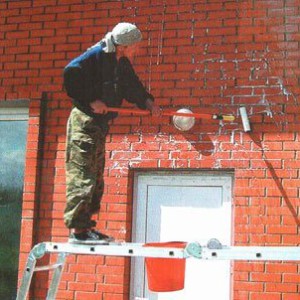
anti-salt solution of walls
The product is sold in a concentrated form and is diluted with water. So, 1 liter of the product can be used to process at least 150 square meters of any surface.
It is important to properly dilute the working solution. The surface to be treated must be clean and dry.
It is better to pre-treat the wall with antiseptic agents in order to disinfect the surface.
In order to work with such products, no special skills are required, since ease of use is another advantage of the water repellent. Unlike foreign counterparts, domestic concentrate is consumed much less, since even in the presence of moisture, additional costs for surface treatment are not required.
Apply a thin layer of impregnation for brick walls. If necessary, then a short interval of 10-15 minutes should be maintained before the next layer. The duration of the funds can vary from 10 to 12 years. Throughout the entire period of operation, the wall will be reliably protected from harmful mold and other fungal formations. After processing, the wall does not change its appearance at all.
